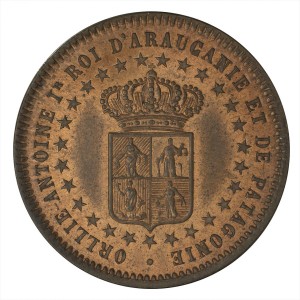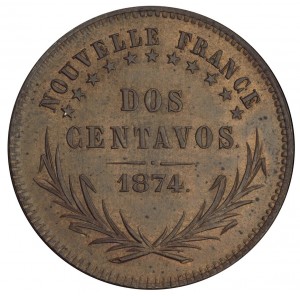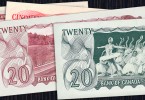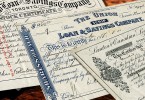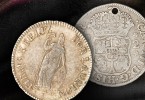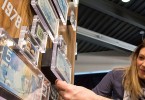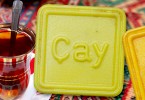Coins from a nation that wasn’t: Araucania and Patagonia
By David Bergeron, Curator
D’Antoine de Tounens in a meeting with the Mapuche people of Patagonia. (Wikimedia Commons, Jules Peco?)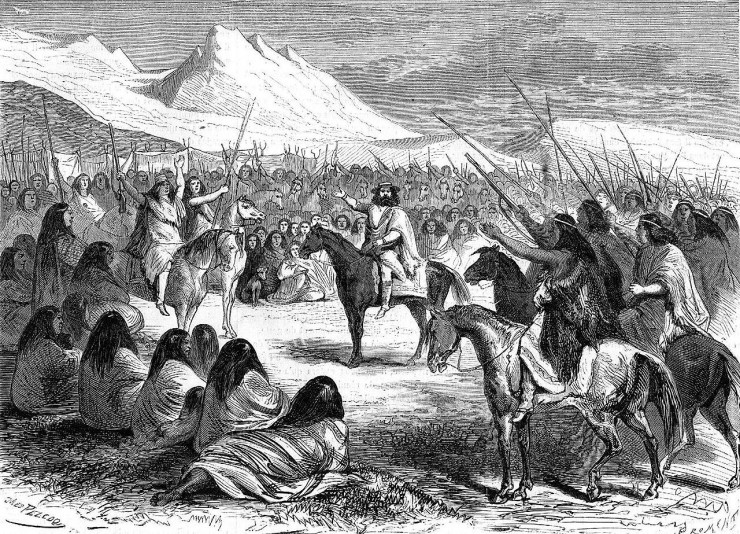
It is not unusual for “micro-nations”— city-states, principalities or minor kingdoms—to produce their own currency. Having a national currency is one way that a fledgling nation can promote its independence—sometimes before there even is a nation. But this coin, from a purely conceptual country in South America, is most intriguing for the history it now represents: the attempt of an indigenous people to establish their own nation in the face of colonization. Even more intriguing, what’s stamped on the coin implies this imaginary nation had already been colonized–by France.
Patagonia from the survey by the British ships Adventure and Beagle. (Wikimedia Commons, John Arrowsmith, 1842)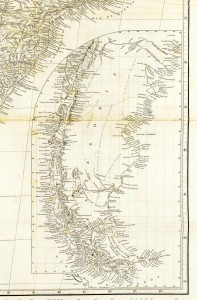
In the middle of the 19th century, a French lawyer and adventurer named d’Antoine de Tounens became fascinated by the Mapuche people of the Patagonia region of South America. The Mapuche were struggling to protect their ancestral lands, their identity and their culture from colonial expansion by the governments of Chile and Argentina. De Tounens went to Chile in 1858 to meet the Mapuche, whom he admired for what he regarded as their heroic resistance, and took up their campaign for self‑determination and sovereignty. In co-operation with their leaders, de Tounens drafted a constitution for “Araucania and Patagonia”, a region located in the southern half of modern Chile and Argentina. They declared the district a kingdom and de Tounens was named as its first monarch. The Chilean government arrested him in 1862, put him on trial and declared him insane. Narrowly avoiding execution, de Tounens was deported to France.
The National Currency Collection possesses three 2-centavo coins minted for Araucania and Patagonia in 1874. What is so curious about these coins is that they claim this potential nation for France. The legend on the reverse reads “NOUVELLE FRANCE / DOS / CENTAVOS / 1874". De Tounens appeared to have baptized the nation as part of New France, yet this designation is seen nowhere else but on the coins. The coins don’t originate from South America but by some accounts may have been struck, presumably at de Tounens’ request, in Belgium.
De Tounens intended to take the coins back with him to Patagonia to help re-establish his kingdom. Although he returned and failed on several occasions, a number of countries did choose to recognize his fledgling state. But it was not to be. In 1878, Orélie-Antoine de Tounens (as his magisterial name was) died in France as the exiled King of Araucania and Patagonia. A successor to the office of Royal Highness to the Crown of Araucania and Patagonia (in exile) still lives in France today–Prince Antoine IV.
The Museum Blog
Unpacking the Collection 1
By: David Bergeron
In the mid 60s, high denomination notes were in such low circulation that Bank of Canada Governor Louis Rasminsky and the Minister of Finance discussed the possibility of actually dropping the denomination altogether.
New Acquisitions
By: Paul S. Berry
The Canadian financial system of today is diverse… A little known but once prolific system member was loan and building societies. These firms made loans for the construction or purchase of property against mortgages as collateral.
New Acquisitions
By: Raewyn Passmore
Everyone loves getting presents, and we’re no exception. We recently received a very exciting donation of 50 silver coins. The collection was purchased in Lima, Peru, at an estate sale in the 1950s.
The Adventure of Exhibit Planning IX
By: Graham Iddon
Our little team from the Museum stood in the education space of the Sherbrooke Nature and Science Museum on a chill November morning while the exhibition technicians assembled our finished exhibition. Yes, finished.
An Exhibition Installation
By: Graham Iddon
You could work in the exhibition-fabrication business all your life and still run into things you wouldn’t expect: a never-ending series of “uh-ohs.” It’s one of the things that makes the job so interesting and demands a high level of creative problem-solving skills…
New Acquisitions
By: Raewyn Passmore
What do you think of when you think of money? Is it coins? Is it bank notes? Three-hundred years ago people weren’t sure bank notes were really money; it took a long time for them to get used to the idea.
Royal Canadian Numismatic Association Convention
The show… is an ideal opportunity for the Bank of Canada Museum to share a part of the National Currency Collection with Canadians. This year, we decided to tell the story of Canada’s phantom banks and the financial crisis of 1837.
